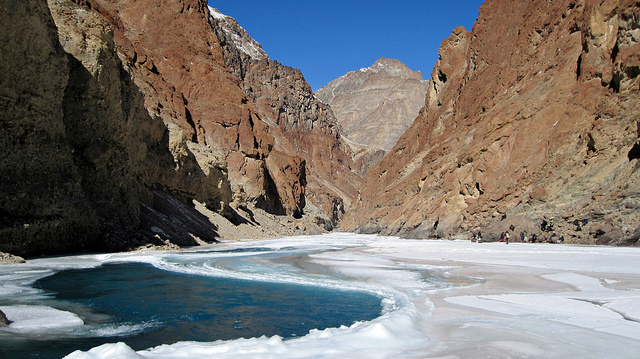A team of experts from the National Disaster Management Authority (NDMA) has succeeded in creating a channel to release water from the huge artificial lake formed by a river blockade due to a landslide in Ladakh’s Zanskar region mid-January.
The water did not immediately start to flow out of the channel at the speed the experts had anticipated, but they are expecting the flow to increase as it gradually deepens the breach.
Meanwhile, the authorities in the Himalayan state of Jammu and Kashmir have issued fresh flash flood warnings to people downstream. Around 300 people at high risk were shifted from their homes in February.
As reported by thethirdpole.net, the landslide blocked Phutkal river in Zanskar area of Ladakh’s Kargil district on January 15, creating a lake where water kept accumulating constantly and is still doing so.
Read Huge landslide blocks river, threatens Ladakh
The aerial survey carried out in the beginning, following constant appeals from the local Member of Parliament and district administration, could not yield any reliable information about the potential disaster. The central government finally sent experts from the NDMA who first carried out the ground survey before starting to create a channel on March 3.
Using explosives in a controlled manner, the experts of NDMA have dug the channel with the support of Ladakh Scouts, an infantry regiment of the Indian Army. The men of the regiment are also known as Snow Warriors – hailing from Ladakh, they are used to the extreme winters of this cold desert.
Also read Blocked Ladakh river to be cleared with explosives
“It took them around one week to dig the channel,” Skalzang Wangyal, the Executive Councillor for Zanskar Affairs in Ladakh Autonomous Hill Development Council (LAHDC), told thethirdpole.net.
He said that the channel was 100 metres long, two metres wide and two metres deep. The water, he said, has started flowing out of the lake. It is expected that the breach will gradually deepen and widen on its own as water keeps passing through it.
Constant monitoring
A government statement issued on March 18 said that an automatic water level sensor has been installed at a Buddhist monastery on the banks of the river downstream, from which data is being relayed every 15 minutes.
The water level downstream of the landslide has seen a steady increase, the statement said, adding that planes will monitor the water flow every day for the next three days. “Two camerapersons from the state information department have also been embedded with the team for facilitating video streaming of the operation,” it added.
Chief Secretary of Jammu and Kashmir government Mohammad Iqbal Khandey has said that there is an apprehension that with gradual increase in temperature, the danger of sudden flow of large volume of water will also rise. “People need to be kept at safer places and water levels monitored round the clock.”
Councillor Wangyal said 15 government employees equipped with satellite phones have been deployed in various remote areas of the district to provide constant updates to the people in those areas.

